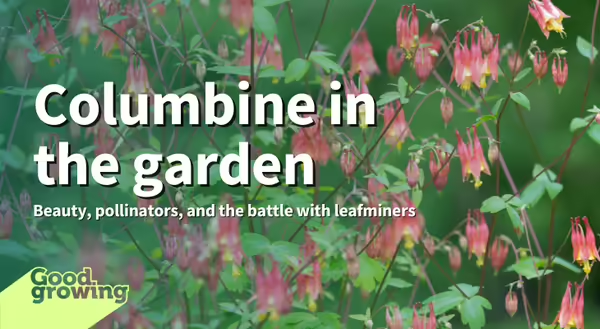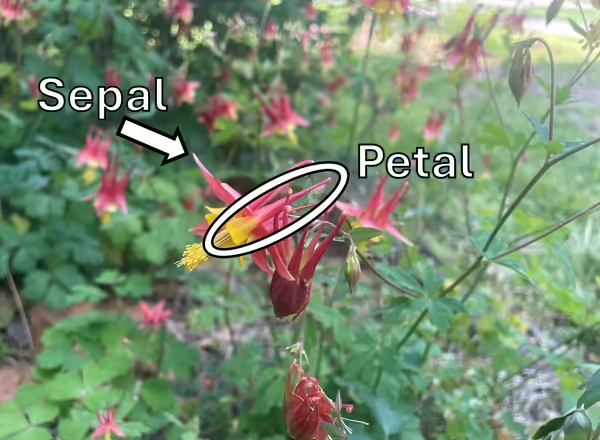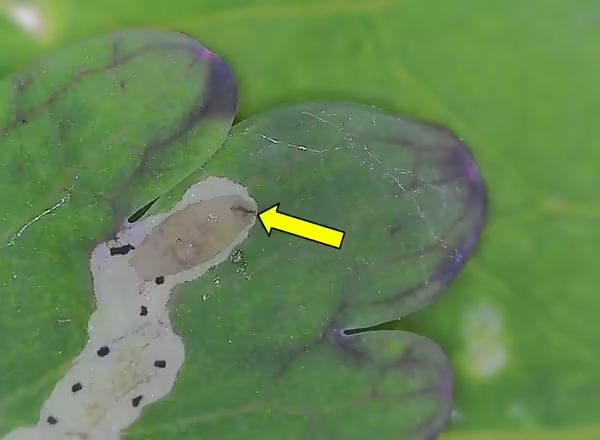
Columbines are popular garden plants. They can be found in a variety of colors, ranging from red, pink, yellow, white, purple, and blue, and they can help fill the gap between early spring blooming plants like tulips and daffodils and the summer blooming plants that dominate our landscapes.
Columbine flowers are unique and instantly recognizable. They have five petals that extend upwards, forming a tubular spur and five petal-like sepals. The flowers will often nod towards the ground, but some species, and many hybrids, will have upright-facing flowers.

Growing columbine in the garden
Columbines belong to the genus Aquilegia, which contains around 65 different species. One of the most popular columbines to grow is the native wild/Canadian/eastern red columbine, A. canadensis. It has yellow and red flowers. However, several other species and numerous hybrids are available.
Depending on the species, columbines can range in size from 6 inches to 3 feet tall. They prefer moist, well-drained soils in light to partial shade, but will grow in full sun if the soil is kept moist. However, they will not tolerate poorly drained soils. While they are perennials, they are often short-lived. However, some, like wild columbine, will readily self-seed and may spread throughout a landscape.
Columbine can also support a variety of wildlife. Not only are the flowers of columbine attractive to us humans, but they are also attractive to several different pollinators. The nectar is located deep in the spurs, so it is visited by pollinators with long tongues, like ruby-throated hummingbirds (columbine is often blooming as hummingbirds migrate north in the spring), bumble bees, and hawk moths.
Columbine is relatively pest-free; deer and rabbits may nibble on the foliage, but rarely feed heavily on it. However, there is one pest that may occasionally cause problems: columbine leafminers.
Columbine leafminers
There are a few species of leafminers that will attack columbines, but the most commonly encountered species in Illinois is the columbine leafminer, Phytomyza aquilegivora.
Columbine leafminers are small flies and will overwinter in the soil as pupae. In the spring, adults will emerge, and females will lay eggs on the leaves of columbine plants, around the time they begin blooming. The larvae will tunnel into the leaves and start feeding in between the upper and lower leaf surfaces, creating serpentine (snake-like) mines.
The larvae have rake-like mouthparts that they will swing back and forth like a scythe as they feed, forming their mines. As the larvae grow larger, their mines will become wider. Their mines will also contain their droppings, or frass, which will look like small black spots.
Once the larvae are done feeding, they will cut a hole in the leaf and will pupate on the underside of the leaf. There are multiple generations per year.



Fortunately, the damage they cause is typically only cosmetic, but heavy infestations may reduce the vigor of plants. If leafminers are a concern on columbine, there are several things that can be done to manage them.
- Removing and destroying infested leaves can help reduce larval populations; this should be done before they pupate.
- Removing and destroying infested plant parts and cultivating around infested plants can help reduce the number of overwintering pupae in the soil.
- Some plants are more prone to being attacked by columbine leafminer than others. Researchers in Georgia found that A. caerulea ‘Dwarf Fantasy Mix’, Wild columbine (A. canadensis), and fan-leaved columbine (A. flabellata) were less affected by leafminers than other species and cultivars.
The most heavily attacked plants were alpine columbine (A. alpina), A. chrysantha ‘Yellow Star’, Colorado columbine (A. caerulea), A. caerulea ‘McKana mix’, A. caerulea ‘Music hybrid’, Mexican columbine (A. skinneri), and A. x hybrida ‘Ruby Port’. So, if you have issues with leafminers, avoid these species and cultivars and consider growing cultivars or species that are less affected. - Chemicals are typically not recommended for the management of columbine leafminers. Once the larvae are inside leaves, contact insecticides will not work, so timing is critical. Additionally, they may also kill natural enemies and other beneficial insects that may be present…
- The same researchers in Georgia found eleven different species of parasitoid wasps attacking columbine leafminers. While the leafminers will still do some damage before they are killed, the parasitoids will help reduce subsequent populations.
Good Growing Fact of the Week: The name columbine comes from the Latin word columba, meaning dove, because the flowers were thought to resemble a group of doves. The genus name Aquilegia is derived from aquila, meaning eagle, because the flower’s spurred petals resemble an eagle’s talons.
References and for more information
Armitage, A M. 2020. Herbaceous Perennial Plants: A Treatise on Their Identification, Culture, and Garden Attributes. Champaign, Illinois: Stipes Publishing, LLC.
Braman, S.K, G.D Buntin, and R.D Oetting. 2005. “Species and Cultivar Influences on Infestation by and Parasitism of a Columbine Leafminer (Phytomyza Aquilegivora Spencer).” Journal of Environmental Horticulture 23 (1): 9–13. https://doi.org/10.24266/0738-2898-23.1.9.
Cory, E. N. 1916. “The Columbine Leaf-Miner.” Journal of Economic Entomology 9 (4): 419–24. https://doi.org/10.1093/jee/9.4.419.
Needham, James G., S. W. Frost, and Beatrice Hughes. Tothill. 1928. Leaf-Mining Insects. Baltimore: The Williams & Wilkins Company. https://www.biodiversitylibrary.org/item/28922.
Want to get notified when new Good Growing posts are available? SIGN ME UP!
Give us feedback! How helpful was this information (click one): Very helpful | Somewhat helpful | Not very helpful
MEET THE AUTHOR
Ken Johnson is a Horticulture Educator with University of Illinois Extension, serving Calhoun, Cass, Greene, Morgan, and Scott counties since 2013. Ken provides horticulture programming with an emphasis on fruit and vegetable production, pest management, and beneficial insects. Through his programming, he aims to increase backyard food production and foster a greater appreciation of insects.